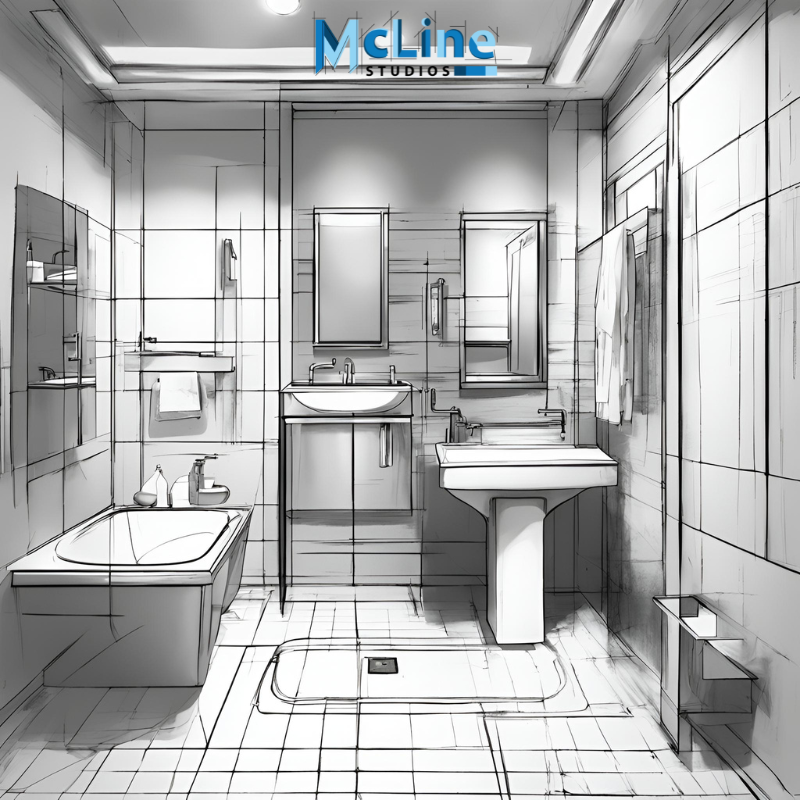The layout and design of a bathroom play a pivotal role in shaping not only its functionality but also its overall aesthetic appeal. Thoughtful planning and attention to detail are essential in crafting a space that seamlessly combines form and function. From optimizing spatial efficiency to creating a soothing ambiance, every aspect of bathroom design contributes to the user experience.
A well-designed bathroom enhances daily routines, promotes relaxation, and adds value to the home. In this guide, we’ll explore the key considerations for comprehending bathroom layout and design, empowering homeowners to create spaces that are both practical and visually captivating.
Space Planning
Assessing available space is crucial in optimizing the functionality and aesthetics of a bathroom. Dimensions and layout constraints dictate the placement of fixtures and storage elements, ensuring efficient use of space. Factors like traffic flow, accessibility, and functionality heavily influence space planning decisions.
A well-planned layout minimizes congestion, enhances usability, and improves accessibility for users of all ages and abilities. By strategically positioning fixtures and considering user needs, space planning maximizes the potential of the bathroom, creating a harmonious environment that meets both practical and aesthetic requirements.
Fixture Placement
Strategic placement of fixtures like sinks, toilets, showers, and bathtubs is essential for an efficient and visually appealing bathroom layout. Considerations include proximity to plumbing lines, natural light sources, and adjacent fixtures to optimize functionality. For instance, placing the toilet in a private alcove enhances privacy, while locating the sink near the entrance promotes accessibility.
Balancing fixture placement ensures efficient traffic flow and maximizes space utilization. Additionally, maintaining visual balance by distributing fixtures evenly throughout the space enhances the overall aesthetic appeal, creating a harmonious and inviting bathroom environment.
Storage Solutions
Adequate storage is essential for organizing bathroom essentials and maintaining a clutter-free environment. Incorporating various storage options optimizes space utility and enhances functionality. Cabinets provide concealed storage for toiletries and cleaning supplies, while open shelves offer easy access to frequently used items.
Built-in niches and recessed shelving utilize wall space efficiently without encroaching on floor area. Additionally, vanity drawers and under-sink organizers maximize storage capacity while keeping the countertop clear. By integrating a combination of storage solutions tailored to the user’s needs, the bathroom becomes not only functional but also visually appealing, promoting a sense of tranquility and orderliness.
Lighting Design
Lighting plays a crucial role in enhancing both the functionality and ambiance of the bathroom. Task lighting, such as vanity lights, ensures proper illumination for grooming tasks. Ambient lighting, such as overhead fixtures or wall sconces, sets the overall mood and brightness levels.
Accent lighting, such as LED strips or recessed lighting, adds visual interest and highlights architectural features. The strategic placement of these lighting types ensures balanced illumination throughout the space, minimizing shadows and glare. By combining different lighting layers, the bathroom becomes a versatile environment that promotes relaxation and efficiency, catering to various tasks and moods.
Ventilation and Moisture Control
Proper ventilation is essential in the bathroom to mitigate mold, mildew, and moisture-related issues, preserving indoor air quality and structural integrity. Installing exhaust fans effectively removes excess humidity and odors, promoting air circulation and preventing condensation buildup.
Natural ventilation methods, such as operable windows or skylights, supplement mechanical ventilation and harness natural airflow to expel damp air. Additionally, sealing gaps around windows and doors and using moisture-resistant materials further enhance moisture control. By implementing these strategies, homeowners can maintain a healthy and comfortable bathroom environment while safeguarding against the detrimental effects of excess moisture.
Material Selection
Choosing the right materials for flooring, walls, countertops, and fixtures is paramount in creating a functional and aesthetically pleasing bathroom. Options range from durable porcelain tiles for flooring to moisture-resistant paint for walls, each selected based on factors like durability, ease of maintenance, and desired aesthetic.
Natural stone or quartz countertops offer durability and timeless elegance, while chrome or brushed nickel fixtures add a touch of sophistication. Material choices not only impact the durability and maintenance of the bathroom but also contribute significantly to its overall ambiance, reflecting the homeowner’s style and enhancing the visual appeal of the space.
Conclusion:
Understanding the layout and design of a bathroom requires careful consideration of space planning, fixture placement, storage solutions, lighting design, ventilation, moisture control, and material selection. Thoughtful planning, attention to detail, and collaboration with design professionals are crucial in creating a functional and visually stunning bathroom space.
By incorporating these key considerations, homeowners can optimize the usability, comfort, and aesthetic appeal of their bathrooms, transforming them into personalized sanctuaries that cater to their needs and reflect their individual style. With the right approach and expertise, every bathroom can become a harmonious blend of form and function, enhancing the overall quality of life.

